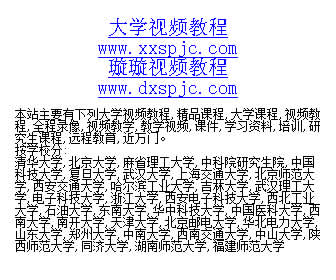
书名:Designing Web Navigation: Optimizing the User Experience
作者:James Kalbach
出版:O’Reilly Media 2007
页数:456页
ISBN:0596528108
简介:最新的Web导航设计理念,本书对Web网站的结构、设计进程、网站规划、版面和设计、CI设计、美工设计、页面元素设计、动画设计、数据库设计、网站的建设和管理等内容进行了详细讲解。 本教材结合了大量的图例、经典页面,注重理论与实践的结合,从而使学习者全面、系统地掌握网站设计的方法和技巧,以及网页、网站的规划和建设技术,并将所学的网页制作技术、数据库技术和网络程序设计技术加以综合的应用。
Book Description
Thoroughly rewritten for today's web environment, this bestselling book offers a fresh look at a fundamental topic of web site development: navigation design. Amid all the changes to the Web in the past decade, and all the hype about Web 2.0 and various "rich" interactive technologies, the basic problems of creating a good web navigation system remain. Designing Web Navigation demonstrates that good navigation is not about technology-it's about the ways people find information, and how you guide them.
Ideal for beginning to intermediate web designers, managers, other non-designers, and web development pros looking for another perspective, Designing Web Navigation offers basic design principles, development techniques and practical advice, with real-world examples and essential concepts seamlessly folded in. How does your web site serve your business objectives? How does it meet a user's needs? You'll learn that navigation design touches most other aspects of web site development. This book:
*Provides the foundations of web navigation and offers a framework for navigation design
*Paints a broad picture of web navigation and basic human information behavior
*Demonstrates how navigation reflects brand and affects site credibility
*Helps you understand the problem you're trying to solve before you set out to design
*Thoroughly reviews the mechanisms and different types of navigation
*Explores "information scent" and "information shape"
*Explains "persuasive" architecture and other design concepts
*Covers special contexts, such as navigation design for web applications
*Includes an entire chapter on tagging

While Designing Web Navigation focuses on creating navigation systems for large, information-rich sites serving a business purpose, the principles and techniques in the book also apply to small sites. Well researched and cited, this book serves as an excellent reference on the topic, as well as a superb teaching guide. Each chapter ends with suggested reading and a set of questions that offer exercises for experiencing the concepts in action.
Dedication
Preface
Part I: Foundations of Web Navigation
Chapter 1. Introducing Web Navigation
Section 1.1. CONSIDERING NAVIGATION
Section 1.2. THE NEED FOR NAVIGATION
Section 1.3. WEB NAVIGATION DESIGN
Section 1.4. SUMMARY
Section 1.5. QUESTIONS
Section 1.6. FURTHER READING
Chapter 2. Understanding Navigation
Section 2.1. INFORMATION SEEKING
Section 2.2. SEEKING INFORMATION ONLINE
Section 2.3. WEB BROWSING BEHAVIOR
Section 2.4. INFORMATION SHAPE
Section 2.5. EXPERIENCING INFORMATION
Section 2.6. SUMMARY
Section 2.7. QUESTIONS
Section 2.8. FURTHER READING
Chapter 3. Mechanisms of Navigation
Section 3.1. STEP NAVIGATION
Section 3.2. PAGING NAVIGATION
Section 3.3. BREADCRUMB TRAIL
Section 3.4. TREE NAVIGATION
Section 3.5. SITE MAPS
Section 3.6. DIRECTORIES
Section 3.7. TAG CLOUDS
Section 3.8. A–Z INDEXES
Section 3.9. NAVIGATION BARS AND TABS
Section 3.10. VERTICAL MENU
Section 3.11. DYNAMIC MENUS
Section 3.12. DROP-DOWN MENUS
Section 3.13. VISUALIZING NAVIGATION
Section 3.14. BROWSER MECHANISMS
Section 3.15. SUMMARY
Section 3.16. QUESTIONS
Section 3.17. FURTHER READING
Chapter 4. Types of Navigation
Section 4.1. CATEGORIES OF NAVIGATION
Section 4.2. PAGE TYPES
Section 4.3. SUMMARY
Section 4.4. QUESTIONS
Section 4.5. FURTHER READING
Chapter 5. Labeling Navigation
Section 5.1. THE VOCABULARY PROBLEM
Section 5.2. ASPECTS OF GOOD LABELS
Section 5.3. LABELING SYSTEMS
Section 5.4. PERSUASIVE LABELS
Section 5.5. TRANSLATING LABELS
Section 5.6. SOURCES OF LABELS
Section 5.7. SUMMARY
Section 5.8. QUESTIONS
Section 5.9. FURTHER READING
Part II: A Framework for Navigation Design
Chapter 6. Evaluation
Section 6.1. QUALITIES OF SUCCESSFUL NAVIGATION
Section 6.2. EVALUATION METHODS
Section 6.3. SUMMARY
Section 6.4. QUESTIONS
Section 6.5. FURTHER READING
Chapter 7. Analysis
Section 7.1. BUSINESS GOALS
Section 7.2. UNDERSTANDING CONTENT
Section 7.3. UNDERSTANDING TECHNOLOGY
Section 7.4. USER INTELLIGENCE
Section 7.5. PERFORMING PRIMARY USER RESEARCH
Section 7.6. CONSOLIDATING RESEARCH FINDINGS
Section 7.7. SCENARIOS
Section 7.8. SUMMARY
Section 7.9. QUESTIONS
Section 7.10. FURTHER READING
Chapter 8. Architecture
Section 8.1. PERSUASIVE ARCHITECTURE
Section 8.2. NAVIGATION CONCEPT
Section 8.3. INFORMATION STRUCTURES
Section 8.4. ORGANIZATIONAL SCHEMES
Section 8.5. SITE MAPS
Section 8.6. SUMMARY
Section 8.7. QUESTIONS
Section 8.8. FURTHER READING
Chapter 9. Layout
Section 9.1. DETERMINING NAVIGATION PATHS
Section 9.2. VISUAL LOGIC
Section 9.3. PAGE TEMPLATES
Section 9.4. WIREFRAMES
Section 9.5. SUMMARY
Section 9.6. QUESTIONS
Section 9.7. FURTHER READING
Chapter 10. Presentation
Section 10.1. INFORMATION DESIGN
Section 10.2. INTERACTING WITH NAVIGATION
Section 10.3. GRAPHIC DESIGN
Section 10.4. SPECIFYING NAVIGATION
Section 10.5. SUMMARY
Section 10.6. QUESTIONS
Section 10.7. FURTHER READING
Part III: Navigation in Special Contexts
Chapter 11. Navigation and Search
Section 11.1. NAVIGATION PRIOR TO SEARCH
Section 11.2. NAVIGATION AFTER SEARCH
Section 11.3. FACETED BROWSE
Section 11.4. SUMMARY
Section 11.5. QUESTIONS
Section 11.6. FURTHER READING
Chapter 12. Navigation and Social Tagging Systems
Section 12.1. TAGGING
Section 12.2. NAVIGATING SOCIAL CLASSIFICATIONS
Section 12.3. SUMMARY
Section 12.4. QUESTIONS
Section 12.5. FURTHER READING
Chapter 13. Navigation and Rich Web Applicatios
Section 13.1. RICH WEB APPLICATIONS
Section 13.2. NAVIGATING RICH WEB APPLICATIONS
Section 13.3. DESIGNING RICH WEB APPLICATIONS
Section 13.4. SUMMARY
Section 13.5. QUESTIONS
Section 13.6. FURTHER READING
References
Colophon
Index

